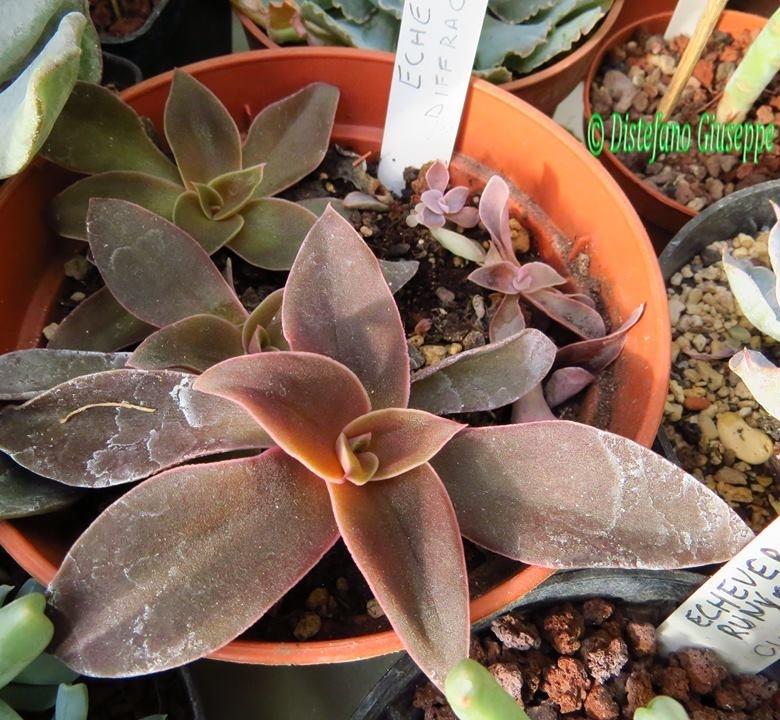
Echeveria diffractens Photo by: Giuseppe Distefano
Origin and Habitat: Echeveria diffractensSN|34239]]SN|34239]] is endemic to the central portion of the state of Veracruz, Mexico.
Altitude range: Around 300 metres above sea level.
Habitat and ecology: This is a rare species, that grows at low altitude in tropical deciduous forest in canyons on volcanic rocks. It is threatened of extinction due to loss of habitat. Flowering November-January.
Synonyms:
Common Names include:
ENGLISH: Shattering Echeveria
Description: Echeveria diffractensSN|27131]]SN|34239]] is a glabrous, perennial, stemlesss or short stemmed, succulent species that forms solitary, flattened rosettes only 2-5 cm tall and 10 cm wide. The leaves are spatulate in shape with, rounded to obtuse apex reddish purple or pinkish-grey-violet with a light thin cream outline. In late winter to spring several unbranched erect flowering stems are produced from the centre of the rosette. As the inflorescence ages it elongates and becomes less erect with the stem leaves easily falling off as the many pale orange flowers emerge. New plants can be grown from the small leaflets (bracts) on the flower stalk. It isn't a fast grower but produces flowers on very small plants. This is typically a solitary plant in habitat but in cultivation older plants will often be in a cluster.
derivation of specific name: diffractens Latin, “breaking into pieces”, or “shattering”; for the easily detached bracts. The name was originally misspelled “difractens”.
Stem: Less than 5 cm tall.
Rosettes: Solitary or rarely proliferous, flattened 7 -10 cm in diameter, 2-3 cm high, flattened with up to 30 leaf-sheets.
Leaves: Oblanceolate to spatulate, obtuse, cuspidate, 3.5-4.5 long, 1-1.2(-2) cm wide at base, 1.7 -2.2 cm wide above, 4 mm thick, with the upper face flattened and the bottom flattened to
slightly convex, epidermis smooth (non-papillated) light pinkish-grey-violet, blue grey or reddish purple. Margin entire, hyaline. Apex rounded to obtuse, mucronate,
Inflorescences (racemes): Single or rarely 2 per plant, 2- to 3-branched, peduncle (to the first flower) up to 25 cm long, 35 cm in total length, about 4-5 mm in diameter at the base, pale green. Peduncle bracts up to 37, conspicuous, alternate, extended, recurved, obovate, easily shed, up to 18 mm long. 12 mm wide and 7 mm thick, upper face convex, lower face convex to flat green to greyish-green apex acuminate to rounded, mucronate. Bractoles obovate to oblong or lanceolate, up to 8 mm long by 3 mm wide, green to greyish green reddish at the base. Flowers 7-12 per cluster. Pedicels bracteolate up to 1.5 cm long, thick (up to 2 mm in diameter), cream coloured.
Flowers: Sepals united at the base, ascending, ovate-lanceolate, 4-6(-7) mm long, 1.5-2.5 mm wide, blue-green, with the upper and lower face convex. Corolla conical, pentagonal angled, slightly urn shaped at the apex, 11-13(-14) mm long, 6-7(-8) mm in diameter near the base, orange, often yellow near apex. Petals lanceolate, 1.4 cm long by 3.5 mm wide, apex stiff, the inner part yellowish orange. Stamens growing above the petals up to 7 mm long, pale yellow. Anthers yellow. Carpels individual, 6.5 mm long and 2.5 mm wide each, cream coloured. Styles 3 mm long cream coloured. Nectaries 2 mm wide white.
Seeds; Numerous brown.
Chromosome number: n = 18.
Taxonomic notes. Echeveria diffractensSN|34239]]SN|34239]] is allied to Echeveria carnicolorSN|34239]]SN|27131]], differing in its widely oblanceolate, prominently mucronate, thinner, non-papillose pink leaves and orange flowers. The bracts easily detach if touched.
Bibliography: Major references and further lectures
1) Kimnach, M. 2003. Echeveria in: Eggli, Urs (Ed.).“Illustrated Handbook of Succulent Plants, Crassulaceae Illustrated Handbook of Succulent Plants.” Springer, Berlin 2002
2) Urs Eggli, Leonard E. Newton “Etymological Dictionary of Succulent Plant Names”
Springer Science & Business Media, 29 June 2013
3) David Jimeno Sevilla “El género Echeveria (CRASSULACEAE) en Veracruz, México.” Trabajo de la experiencia recepcional en la modalidad de: TESIS Universidad Veracruzana Facultad de Biología. Xalapa, Equez. Ver. 2008.
4) Kimnach & Lau Cact. Succ. J. Amer. vol.,53 pag. 4. 1981.
5) San Marcos Growers "Echeveria diffractens - Shattering Echeveria" <http://www.smgrowers.com/products/plants/plantdisplay.asp?plant_id=3492>. Web. 03 May 2017
 Echeveria diffractens Photo by: Giuseppe Distefano
Echeveria diffractens Photo by: Giuseppe DistefanoSend a photo of this plant.The gallery now contains thousands of pictures, however it is possible to do even more. We are, of course, seeking photos of species not yet shown in the gallery but not only that, we are also looking for better pictures than those already present.
Read More...











